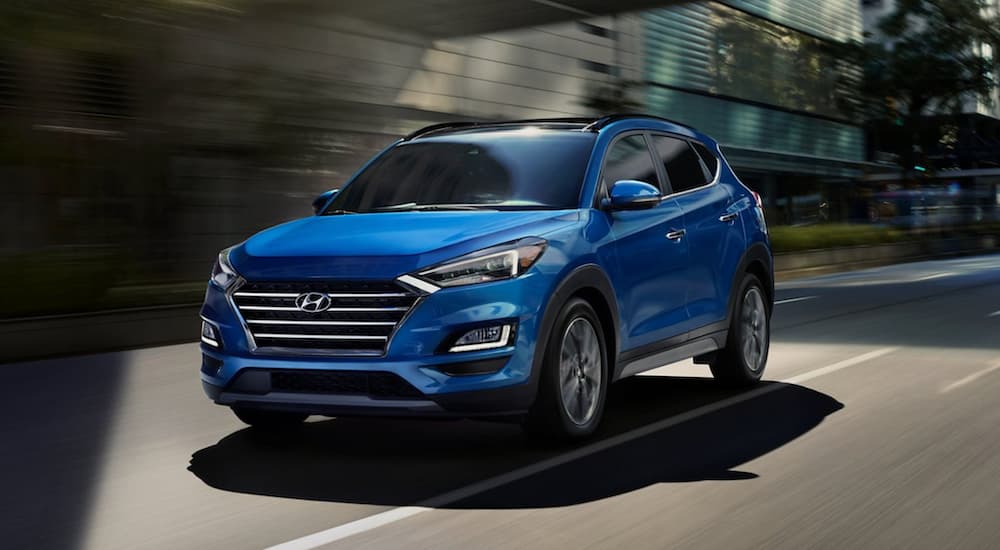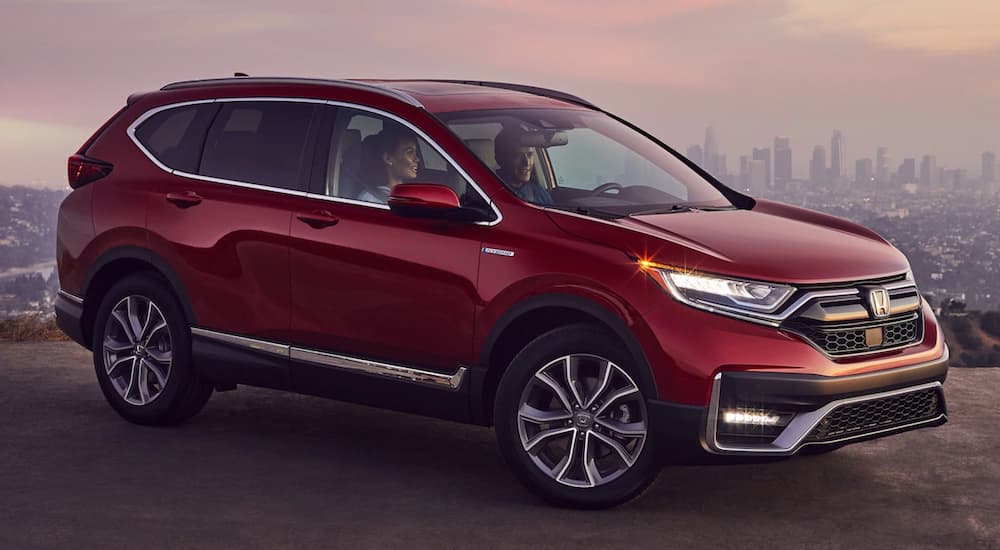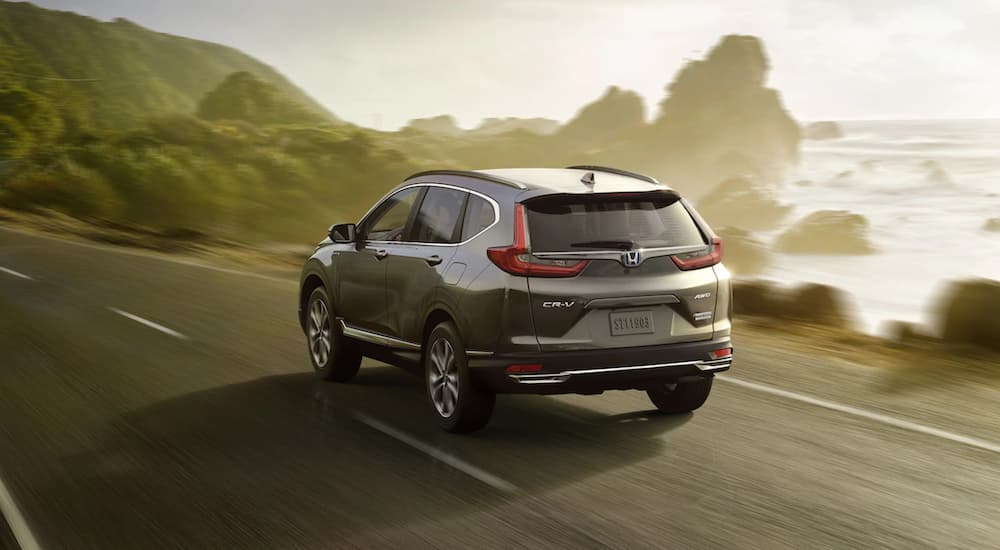When you’re trying to find the right compact SUV, you’re bound to find that no two models are the same. While every brand wants its specific model to look like the best one, you won’t see the truth unless you do a side-by-side comparison. It’s not that competing models are necessarily “bad,” it’s that some give you better specs for your money. You want to choose the model that offers better affordability overall. You’ll quickly see this when we look at the 2021 Honda CR-V vs 2021 Hyundai Tucson.
While you may spend a couple extra thousand on the CR-V outright, its long-term savings make it the more appealing model, especially when it comes to value. You get better features with the CR-V than you do with the Tucson. We’ll dive into that more below, but first, let’s take a quick look at how these companies got started and why they’re both important in the automotive world today.
Brief History of Both Brands
Interestingly enough, Honda and Hyundai brands originated only 1 year apart, with Honda’s debut in 1946 and Hyundai’s in 1947. Honda started off making motorcycles, while Hyundai started off with a Ford Cortina copycat model. As time progressed, Honda began to hit the automotive world alongside motorsports, creating some of the most reliable and durable models on the market.
On the other hand, Hyundai has become less known for its reliability and more known for its affordability. The company focuses on making vehicles that are similar to competing brands but selling them for a lower price. The downside to this is that, generally speaking, you get fewer standard features with a Hyundai model. That, and the quality of standard features is not as sufficient. That said, Honda models are affordable as well, but they offer more high-quality parts and specs. In fact, while millennials struggle more financially than later generations, the Honda Accord is the number one car among millennial drivers.
Overall, while both brands are popular, Honda balances its affordability with impressive specs and high-reliability ratings. As you’ll soon see, the Honda CR-V carries on this legacy by providing more bang for your buck.

Which One Has the Better Performance Specs?
The main aspect you’re looking for when buying a compact SUV is fuel economy. While it may seem that fuel economy ratings for these models are roughly the same, there’s actually a large gap between these two models. The 2021 Hyundai Tucson gets up to 28 miles per gallon on the highway, which sounds appealing at first. However, the 2021 Honda CR-V gets as much as 34 miles per gallon on the highway on average, beating the Tuscon by 7 miles per gallon, and that’s just between the two gasoline models.
Another big perk to the CR-V is that it comes in a hybrid option, whereas the Tucson does not. This gives the CR-V an even bigger edge over its competition. This is because you can get around 40 miles per gallon in the city when you choose a hybrid CR-V. Plus, even the hybrid CR-V offers more horsepower than the Tucson does. In fact, the Hybrid version has more horsepower than the standard gasoline CR-V. At 212 horsepower, the CR-V beats the Tucson’s 181 horsepower rating. Furthermore, the CR-V’s standard 1.5-liter 4-cylinder engine produces up to 190 horses, still beating out the Tucson. Both models include optional all-wheel drive across trims; however, the hybrid CR-V offers all-wheel drive as a standard feature.
Whether you choose the standard gasoline CR-V or the hybrid version, it still outperforms the Tucson. The hybrid version gives better fuel economy, more power, and all-weather driving capabilities without an additional add-on cost. Similarly, the standard gasoline CR-V includes more horsepower and better fuel economy. Since you’re likely looking for a fuel-efficient commuter, the answer is simple here. The 2021 Honda CR-V is the way to go.
Technology Comparisons
The best bargain for your money will offer more standard tech features than the competing model. The truth here is that the new Tucson infotainment center is severely outdated. Its display looks like an older 2010s model. Both models do include Apple CarPlay and Android Auto standard streaming features. However, the CR-V’s connectivity program is much better than Hyundai’s.
HondaLink includes several standard cost-free features, including a parking locator, 24-hour roadside assistance, recall information, and an appointment scheduler. Hyundai’s Blue Link feature is only free for 3 years, and then drivers must purchase a subscription for continued access. Even then, the base-level model does not include the free 3-year Blue Link service.
In addition to these features, the 2021 Honda CR-V vs 2021 Hyundai Tucson battle intensifies when it comes to audio quality. This is because the CR-V comes with a 9-speaker, 330-watt audio system that covers every corner of the model. It even includes a standard subwoofer to handle the bass, improving the speaker’s audio quality and providing a deep bass sound.
Conversely, the Tucson only offers 6 speakers, with a lower 315-watt score. When you upgrade to a higher Tucson trim, you do get up to 8 speakers instead, but this still pales in comparison to the CR-V’s standard 9 speaker option. Rather than having to pay extra for the lesser sound system option, you get better audio quality with the CR-V, even when you choose the base-level LX trim.
All About That Space
Compact SUVs obviously aren’t intended for large families. However, the goal here is to offer more space than the average car model. When comparing the 2021 Honda CR-V vs the 2021 Hyundai Tucson, the Honda comes out way ahead. The CR-V’s cargo score is 39.2 cubic feet when the seats are up and up to 75.8 cubic feet when the seats are down. The Tucson falls short of this, with a 31.0 cubic feet rear rating and 61.9 cubic feet general cargo score. This trend carries over to passenger volume as well, where the CR-V scores 105.9 cubic feet versus the Tucson’s 102.2 cubic feet. The decision between the two is made easy here, where the 2021 Honda CR-V is ahead by a landslide.
Other Factors to Consider: Safety Specs
The catch here is that both models are incredibly safety-efficient. However, while the Honda Sensing Safety Suite is standard across all CR-V models, the Tucson’s safety features increase with each trim. Basically, when you get a base-level Hyundai, you’ll get a few standard safety features, but to get them all, you must keep upgrading trims.
Conversely, even the CR-V’s base trim includes four driver assist features across trims. These include the following:
- Road Departure Mitigation System
- Adaptive Cruise Control with Low-Speed Follow
- Lane Keeping Assist System
- Collision Mitigation Braking System
These features work together to help keep drivers from drifting lanes and following other vehicles too closely. They also help prevent accidents by automatically braking the model when the driver can’t get to it first.
The Winner is Clear
Between its better fuel economy, vast interior space, and better tech and safety standard features, the 2021 Honda CR-V is definitely the compact SUV for you. The main thing to remember here is that the CR-V offers a hybrid option, making it even more fuel-efficient than ever before. Either way you go, though, you’re saving more money with the CR-V than you can with the Hyundai at the end of the day. While the Tucson’s price tag may be slightly lower, its much lower fuel efficiency will quickly balance that out. For long-term savings you can rely on, check out the 2021 Honda CR-V today.





